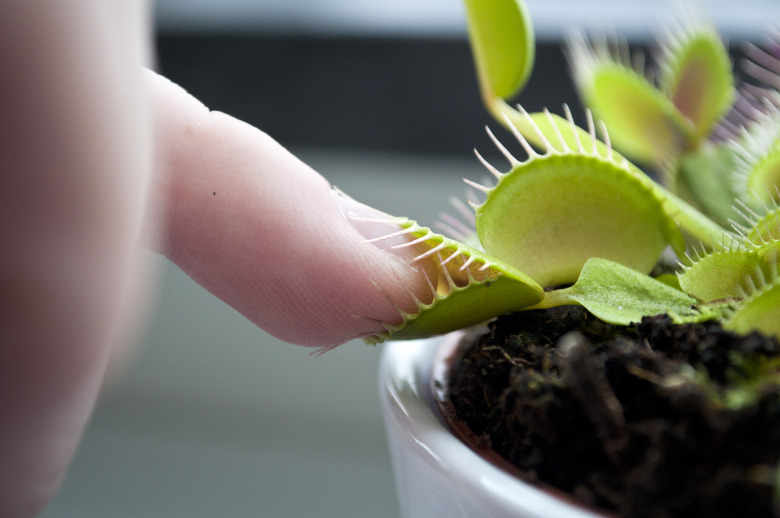What Happens If You Put Your Finger In A Venus Flytrap?
Poking your finger at a Venus flytrap (Dionaea muscipula) is uneventful. If you put your finger in one of the plant's traps and wiggle it around, you can get the trap to close. No harm will come to you, but you may harm the plant. The leaves that form the trap portion of the flytrap can only close so many times before they die, so stimulating them unnecessarily only serves to hasten their end. Springing the leaves of the plant shut also makes them unavailable for photosynthesis. When told not to touch a Venus flytrap, people often assume it's for their own safety. In truth, this admonishment serves to protect the plant.
- Poking your finger at a Venus flytrap (Dionaea muscipula) is uneventful.
- The leaves that form the trap portion of the flytrap can only close so many times before they die, so stimulating them unnecessarily only serves to hasten their end.
Pull My Finger
They may look threatening, but the hinged leaves of a Venus flytrap are actually quite delicate. Although there are tiny trigger hairs inside of them that tell the trap when to close, there are no teeth or other pointy objects inside the trap. When a trap closes around your finger, the sensation is that of eyelashes brushing against you, not teeth biting into you.
The trap itself won't harm you, nor will the plant's digestive juices. A Venus flytrap doesn't begin the digestive process until the trap closes firmly. Your finger is far too big to allow this to happen, so your skin is never exposed to any type of chemical. The trap will gently hold your finger until you pull it away. When you do, the plant will slowly reopen the trap, and you'll go on your way unharmed. You won't even need a Band-Aid.
- They may look threatening, but the hinged leaves of a Venus flytrap are actually quite delicate.
- Your finger is far too big to allow this to happen, so your skin is never exposed to any type of chemical.
Killing Me Softly
Like all plants, Venus flytraps routinely shed old leaves and form new ones. As a result, the traps on any given flytrap have a specific lifespan. In general, a trap will only close around and digest a meal three to five times before dying. If something other than a meal triggers the trap, like a raindrop or a curious human, it'll reopen again quickly rather than wasting time trying to digest nothing. A trap can only withstand up to 10 of these false alarms before dying, however. Every time you poke a trap for fun, you shorten its life span.
Energy Crisis
Plants are living things that need nutrients and energy to survive. Ordinarily, plants meet some of these needs through photosynthesis and get the rest of their nutrients, such as nitrogen, from the soil. Venus flytraps, however, grow only in a small part of North Carolina. The soil in this swampy area is devoid of nitrogen and other nutrients, so the plant has learned to adapt. It gets its nutrients from the insects it eats rather than from the soil.
- Like all plants, Venus flytraps routinely shed old leaves and form new ones.
- In general, a trap will only close around and digest a meal three to five times before dying.
While the majority of the plant's nutrients come from insects, it still uses photosynthesis for energy like other plants. Scientists have noticed, however, that the leaves of the Venus flytrap greatly reduce their photosynthesizing when closed and digesting a meal. It seems the traps don't multitask well, forcing them to choose between processing sunlight or food. When the plant is gaining sustenance from a meal, the loss of energy from photosynthesis is a worthy trade. The plant loses energy, however, if the trap closes without a meal inside. If you close multiple traps with your finger, you're essentially starving the plant and forcing it to exert itself at the same time. This could kill the plant or severely damage it, stunting its growth.
- While the majority of the plant's nutrients come from insects, it still uses photosynthesis for energy like other plants.
- Scientists have noticed, however, that the leaves of the Venus flytrap greatly reduce their photosynthesizing when closed and digesting a meal.
References
- Science Daily: No Such Thing as a Free Lunch for Venus Flytraps
- NC State Univeristy Extension: Dionaea Muscipula
- Scientific American: How Does the Venus Flytrap Digest Flies?
- Tom's Carnivores: FAQ: What Should I Feed my Venus Flytrap?
- The Texas Triffid Ranch: Absolute Surefire Steps to Kill Your Venus Flytrap: Step 5
- Journal of Experimental Botany: On the mechanism Underlying Photosynthetic Limitation Upon Trigger Hair Irritation in the Carnivorous Plant Venus Flytrap (Dionaea Muscipula Ellis)
